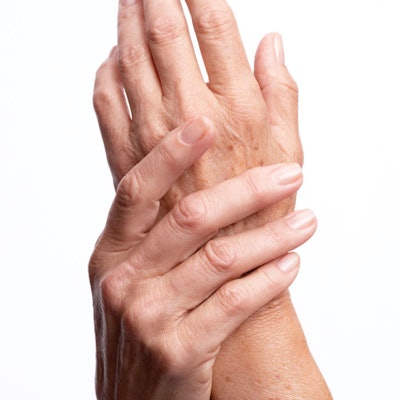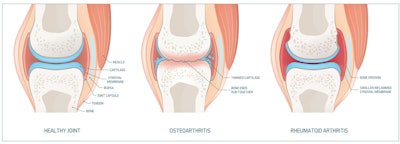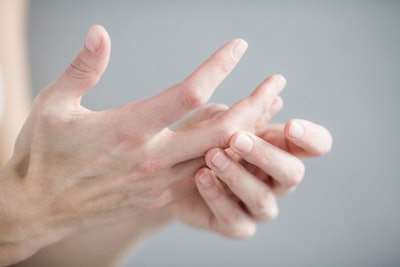
Lisa Silveous, a nail tech in Centerburg, Ohio, hadn’t even graduated from nail school yet when her hand started bothering her. “My left hand began hurting in the thumb joint region when I made a pinching motion to hold a client’s finger in order to file, polish and apply enhancements,” says Silveous, who is now 52 and graduated nail school in 2015. “The more pressure I apply to hold a client’s sidewalls down, the more it hurts.”
The pain came on suddenly, and Silveous at first assumed it was tendonitis. But when she saw her doctor, she got a different diagnosis: osteoarthritis. Tendonitis was a good guess; it can occur with repetitive use, as it affects tendons, which are ropelike structures that join muscles to bone and permit joints to move. Arthritis, on the other hand, involves joints. The pinching and grasping required to do nails can spur arthritis pain, but generally only if you’re genetically predisposed to it, says Barbara Bergin, MD, a board-certified orthopedic surgeon in Austin, Texas. Arthritis tends to affect men less often than women, who might start noticing symptoms in their 40s. “If you get it and you do heavy or repetitive work with your hands, you’re more likely to suffer,” Dr. Bergin says.
Arthritis symptoms can range from mild stiffness to extreme pain that disrupts work for nail techs. Read on to find out how to tell if you might be developing arthritis, and how you can prevent or treat it.
RELATED: Identifying Raynaud’s Syndrome
What is Arthritis?
There are more than 100 different types of arthritis, which is a catchall term to describe pain caused by inflammation in the joints, says Kavita Sharma, MD, a board-certified pain management physician in New York. The two most common types, which can affect the fingers, wrists, knees and hips, are osteoarthritis, which is caused by wear and tear of the joints, and rheumatoid arthritis, an autoimmune condition in which the body starts to attack its joints, resulting in pain and inflammation, Dr. Sharma explains. “All types of arthritis result in pain due to bone-on-bone contact and/or swelling and inflammation,” she says. “In healthy young joints, a sleeve of cartilage surrounds and protects the bones, which provides a cushion for the bones to slide against one another smoothly. As we age, the cartilage can start to thin or fray, which results in bone- on-bone friction and causes pain.” The area that causes Silveous the most pain and discomfort is a common one: the joint at the base of the thumb, called the carpometacarpal joint. The joints of the knuckles in the fingers also are commonly affected by arthritis, Dr. Bergin says.

Telltale Signs
Swelling and/or pain in the joints, stiffness and decreased range of motion are all symptoms of arthritis. In addition to age, excess weight, a family history of arthritis and an injury, such as a ligament tear, increase your risk of experiencing them.
Arthritis sufferers can experience symptoms both on the job and while performing everyday tasks, such as opening jars, turning doorknobs and pinching keys, Dr. Bergin says. Gel and acrylic enhancements are two services that seem to inflame Silveous’ arthritis. “They require a lot of filing—extra time holding my affected hand in different positions to hold the client’s fingers and hands in a position for the filing,” she says. “I’ll sometimes have to readjust myself or take a few seconds to flex and rub my thumb joint so I can continue.”
When to Get Help
See your primary care physician if you’re experiencing pain and stiffness in an area that doesn’t improve with rest and over-the-counter pain relievers after a few weeks, advises Lynn Ludmer, MD, a rheumatologist at Mercy Medical Center in Lutherville, Maryland. “Signs that would be concerning include visible swelling, warmth or redness over the painful area, which could indicate inflammation and may require consultation with a rheumatologist or orthopedist,” she says.
RELATED: How to Manage Your Allergies This Season
How to Combat Arthritis
In the long term, Dr. Bergin says that modifying activities that cause pain is the most important thing you can do to manage arthritis. “Use rubber pads to help you open jars,” she suggests. “Get smaller milk cartons. Stop using big, heavy Yeti cups and switch to things with handles or flexible paper cups.”
Changing up movements and doing things at different angles so you can use a stronger or more ergonomic part of your hand can also help relieve stress on finger joints, adds Alice Holland, DPT, doctor of physical therapy in Hillsboro, Oregon. Squeezing and gripping TheraPutty or small stress balls can help strengthen the hand, which helps with pain. “I’m a big fan of heat therapy for severe arthritis sufferers, since heat helps make joints more malleable,” Dr. Holland says. “A session of paraffin wax therapy at home is great for patients who have morning hand pain.” Other treatments include braces and anti-inflammatory medications, and for more serious cases steroid injections and surgery.
Silveous says cortisone (steroid) injections have helped with her pain, but they wear off after one to two months, and she’s been advised by her doctor that more than two to three treatments a year isn’t healthy. Because she can no longer handle full days doing nails at a salon, she established a studio in her home so she could make her own schedule and better manage her condition. “For now, I find taking arthritis-strength acetaminophen in the morning is helpful when I know I’ll be doing nails,” she says. “The arthritis is a bump in the road and a nuisance, but I will not let it win!”

Arthritis Facts
Arthritis is the leading cause of disability in the United States. Around 54.4 million people in the United States have been diagnosed with arthritis—equating to more than 1 in 4 adults.
Severe joint pain is higher among women and exacerbated by poor health and psychological distress.
Arthritis is more common among people with chronic diseases: 49% of people with heart disease and 47% of people with diabetes also have arthritis.
Thirty-one percent of people who are obese have arthritis.
Physical activity can reduce pain and improve function by nearly 40%.
Source: Arthritis Foundation Arthritis by the Numbers: Book of Trusted Facts & Figures
–by Virginia Pelley
[Images: Getty Images]











